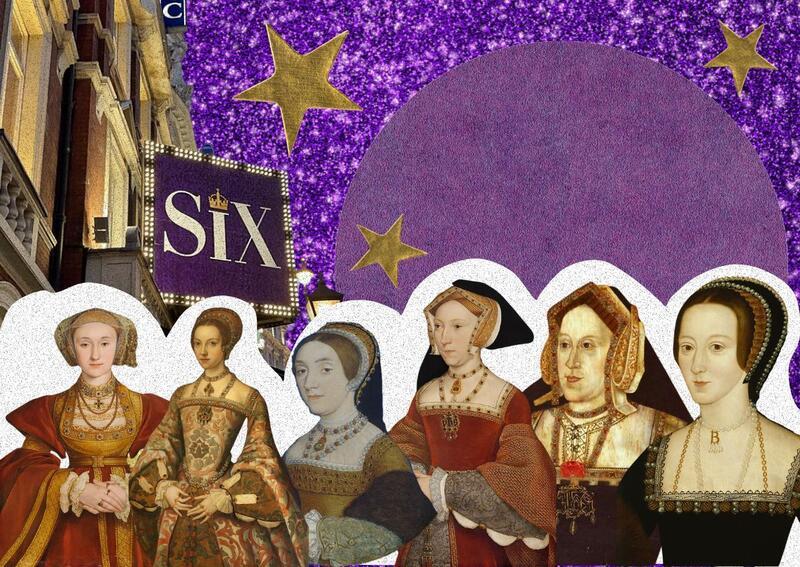Six: A Feminist Musical?
Six is the award-winning “feminist” musical retelling of the lives of Henry VIII’s six wives. Each of the former queens sings one song, and there is a group number at beginning, middle, and end. The musical is initially presented as a contest to see which wife had the worst life married to Henry. The contest is ultimately cancelled before the final number as the women agree that it’s anti-feminist to compare themselves to one another. They come to the realization that they are women with their own lives, not just characters to be seen only in relation to a man.
Written by Lucy Moss and Toby Marlow, Six shares a message of female empowerment by acknowledging the tough reality of Henry VIII’s wives (and all women at the time) and highlighting the wives’ accomplishments.
As a musical, it’s upbeat and fun. It’s full of bright lights, catchy songs, and confetti. It portrays each wife in a unique way that is easy to follow. While being lively, it also holds space for the distressing reality of the women. Most notably, Henry VIII’s fifth wife, Catherine Howard sings a song titled “All You Wanna Do,” which details her experiences of being used and abused sexually by men. The musical’s ability to be both fun and serious, and to do both well, is a rare gift.
While it tackles heavy subjects with sensitivity, Six unfortunately leans heavily on stereotypes in its characterization of Henry VIII’s wives. For example, Catherine of Aragon, Henry VIII’s first wife, wears gold and is presented as a tough queen. She expresses resentment over losing her position as queen: her crown is the largest and most visible of all six, communicating her strength through her costume. Despite the way she’s presented, the only life event of hers that is mentioned is her daughter, Mary, and the number of miscarriages she had. As the longest reigning queen of 24 years, the real Catherine of Aragon had the most time to influence England and leave a lasting impact, notably, she was the first female ambassador in European history. Her strong influence over England inspired many parents to name their daughters after her (including the sixth queen, Catherine Parr).
Catherine of Aragon became Queen Regent in 1513, while King Henry VIII was in France. She played a large part in winning a battle with the Scots—she even sent the bloody king’s cape to her husband. She wasn’t afraid to flaunt her accomplishments to her husband; sending this trophy of her efforts was a way to show that she was capable without him. Despite this accomplishment fitting into the ruthless portrayal of her it is never named in Six. The musical only acknowledges her child and miscarriages, rather than her individual accomplishments, which plays into the idea of her role being a baby-maker and not a leader in her own right.
There is a similar issue with the portrayal of King Henry VIII’s second wife, Anne Boleyn, leaning on stereotypes. Anne wears green, both as a nod to the poem many mistakenly think that Henry wrote about her and because of the color’s malicious associations. In Six, Anne is the somewhat stereotypical dimwitted temptress. The lyrics to the song that introduces her discuss her “plan to steal the man,” establishing her as a promiscuous woman who goes on to cheat on Henry out of revenge. However, this representation is false. There is no substantial evidence that the allegations of her cheating were true. It is a shame that the supposedly feminist musical chooses to portray her as power-hungry and vengeful, rather than acknowledging that she was subject to an unfair trial. In reality, she was only used as a tool for a male heir, and when she did not have one, she was thrown away. Instead of portraying the real, full story, Six unfortunately repeats this sexist inaccuracy.
Yet, the musical seemingly turns itself around when we hear Henry’s sixth wife, Catherine Parr, sing “I Don’t Need Your Love.” She tells her fellow characters that they are more than the man they married and have value outside of their relationship. This inspires the other queens to recognize their worth as well. She acknowledges the other achievements in her life, such as being a published author. Catherine Parr gets her story told, even if not all the other queens don’t.
While Six should have shared the complex stories of its women characters, it is important to recognize that it is a pioneer as a feminist historical Broadway musical. No other Broadway musical has ever retold women’s history in the way Six does. Six created the bar for feminist historical musicals, and I hope the future ones raise it.
This piece was written as part of JWA’s Rising Voices Fellowship.







